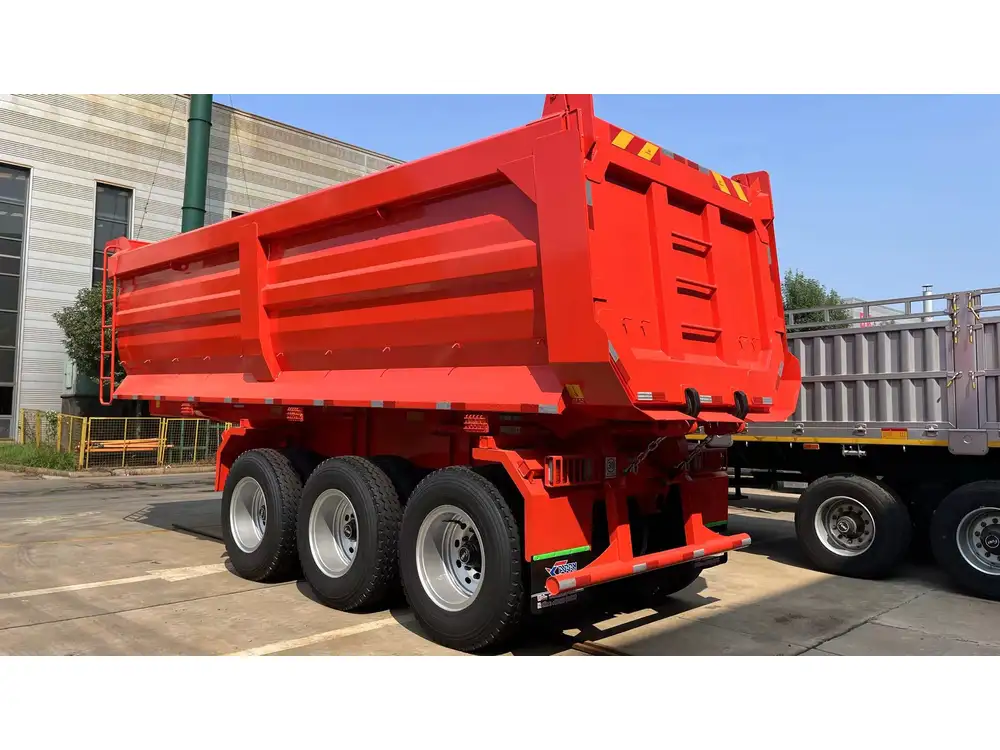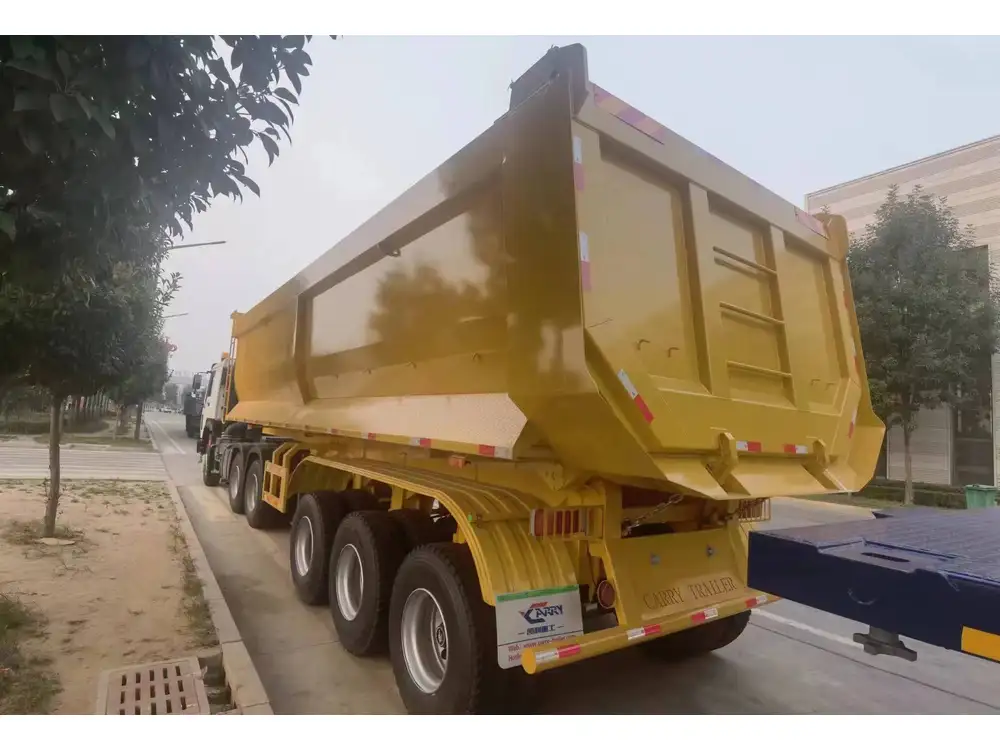When considering the logistics and transportation industry, one increasingly precise question arises: How wide is a semi-trailer door? For manufacturers, suppliers, and transport operators, understanding the specifications of semi-trailer doors is not merely a matter of curiosity but a critical aspect that affects loading, unloading, and overall operational efficiency.
The Standard Width of Semi-Trailer Doors
A standard semi-trailer typically features a rear door that adheres to conventional width dimensions. Generally, the following door sizes are most prevalent:
| Type of Semi-Trailer | Standard Door Width |
|---|---|
| Dry Van Trailers | 92 inches (7 feet 8 inches) |
| Reefer Trailers | 92 inches (7 feet 8 inches) |
| Flatbed Trailers | 96 inches (8 feet) |
However, variations may exist depending on specific chassis designs and manufacturer choices. For instance, certain specialized trailers may feature doors wider than the standard specification to accommodate oversized cargo.
Types of Semi-Trailer Doors

1. Swing Doors
Swing doors are perhaps the most common type of door found on semi-trailers. They offer easy access and a wide opening, promoting efficient loading and unloading. The typical specifications for swing doors also align with the previously mentioned standard widths. However, those involved in transporting wider items may benefit from opting for custom modifications with larger doors.
2. Roll-Up Doors
Roll-up doors differ significantly in design and function. While they provide excellent security and weather resistance, they generally offer slightly less opening width compared to swing doors. Roll-up mechanisms can also impact the functionality; for example, many roll-up doors may restrict the total width by introducing additional frame components.
3. Bi-Fold Doors
As an alternative to the traditional swing doors, bi-fold doors can be quite advantageous. These doors fold back on themselves, providing an unrestricted width when open. The total effective width can reach beyond the standard dimensions, making such doors ideal for specialized freight operations.

Importance of Door Width in Logistics
Understanding the width dimensions of semi-trailer doors holds numerous implications, especially in logistical operations. Here’s how:
A. Loading Efficiency
The effectiveness of loading and unloading procedures significantly depends on the door’s width. Wide openings streamline the loading processes, allowing for the use of larger forklifts and other equipment. If the door is too narrow, it may require more time and effort to maneuver goods.
B. Freight Compatibility
In matching the right trailer to the type of freight being transported, door width becomes crucial. Certain goods, particularly large machinery or oversized packages, necessitate wider doors to ensure safe and efficient transit. For instance, transporting industrial equipment often requires vehicles with suitable door specifications.

C. Conformance to Regulations
Regulatory compliance is another important factor. Certain jurisdictions impose specifications on vehicle dimensions, including the width of transport doors. Understanding these regulations helps avoid costly penalties and ensure smooth operations.
D. Planning for Safety
Safety measures are paramount in transportation. Ensuring the door’s width is sufficient for the type of cargo can prevent accidents and equipment damage. Adequate width reduces the risk of cargo shifting during transit, enhancing stability.
Considerations When Choosing a Semi-Trailer
When selecting a semi-trailer, the following key considerations relate to door dimensions:

1. Cargo Type
Understanding the type of cargo that will be regularly transported is vital. For instance, if your operations frequently involve shipping furniture or large appliances, doors measuring 96 inches may be more advantageous.
2. Access Equipment
Consider the equipment you’ll be utilizing for loading and unloading. For example, if you plan to use specific forklifts that necessitate a wider entry, ensure the trailer door width accommodates such machinery.
3. Frequency of Use
If a semi-trailer is intended for continuous use, investing in a unit with wider doors may yield long-term operational efficiency, even if the current cargo doesn’t necessitate it.

Customizing Your Semi-Trailer Door
For manufacturers and operators who require specific door dimensions, customization can be made based on individual needs. Options for customization include extending door width, height, and even altering the door type based on operational requirements.
Benefits of Customization
- Operational Flexibility: Tailoring your semi-trailer doors provides flexibility when dealing with diverse cargo types.
- Future-Proofing Operations: Customized solutions can safeguard against future operational changes without necessitating wholesale equipment replacement.
- Enhanced Safety: Custom sizes can be crafted to ensure safe handling practices are achievable, often catering to the specific loading environment.
Common Questions About Semi-Trailer Widths and Door Specifications

What is the Maximum Width Allowed for Semi-Trailers?
In many regions, the maximum width for a semi-trailer is regulated. Generally, semi-trailers should not exceed 102 inches (8.5 feet) in width, although regulations may vary. This limitation influences the design and configuration of both the semi-trailer and its doors.
Are There Regulations Governing Door Height?
While width is a principal concern, the height of semi-trailer doors is also regulated. Standard door heights typically range between 100 inches to 110 inches; however, maximum height regulations can differ from state to state.
What Do I Need to Know About Loading Dock Heights?
Loading dock height compatibility is essential in loading and unloading semi-trailers. Standard loading docks typically align with a trailer height of approximately 48 inches, ensuring that operations remain efficient and uninterrupted.

How Can I Ensure My Semi-Trailer Meets Safety Standards?
Maintaining compliance with safety standards involves regular inspections, particularly focusing on trailer and door integrity. Understanding the dimensions that allow seamless loading and incorporate spot checks can substantially contribute to ensuring operational safety.
Conclusion
Grasping the dimensions of semi-trailer doors, particularly the width, encompasses various operational facets in the transportation industry. From impact on loading efficiencies to compliance with regulatory standards, the depth of consideration must resonate throughout the selection and operation of semi-trailers. Tailoring these aspects—whether opting for a roll-up, swing, or bi-fold mechanism—enables businesses to optimize their logistics strategies comprehensively.
In a rapidly evolving industry driven by efficiency, that question—how wide is a semi-trailer door?—holds implications that extend well beyond mere measurements. This knowledge empowers transport operators to make informed decisions that enhance both performance and safety across their logistical frameworks.



